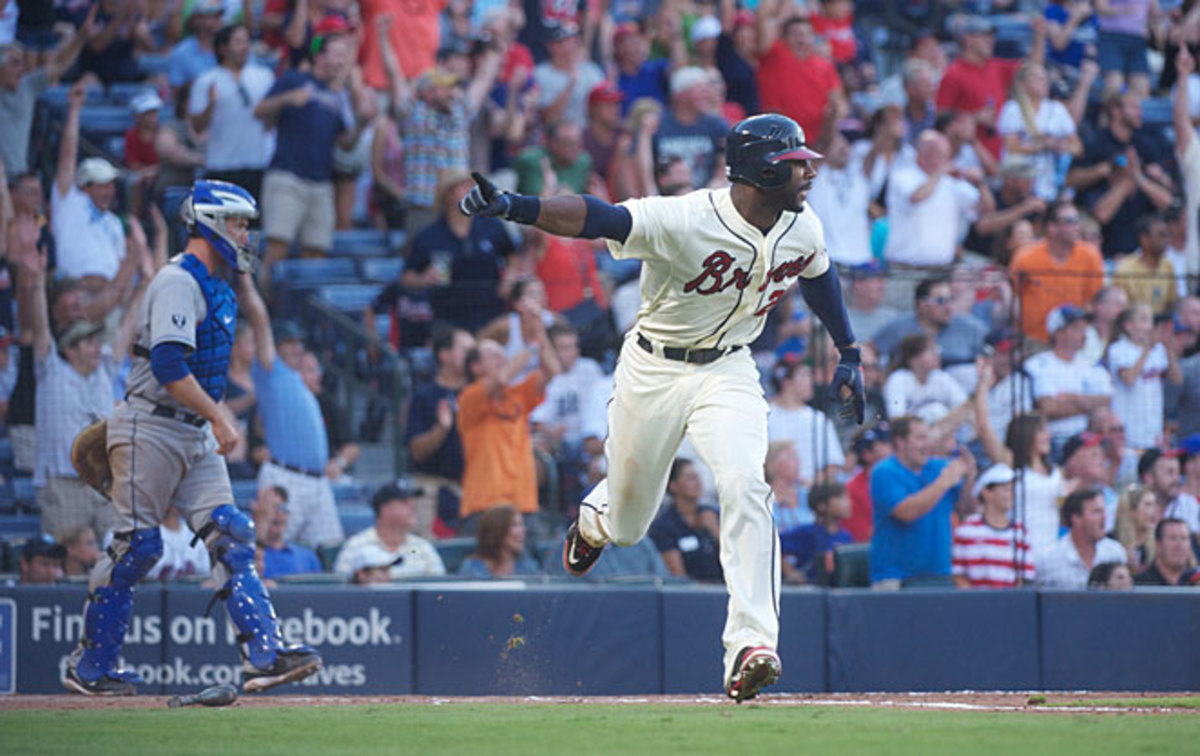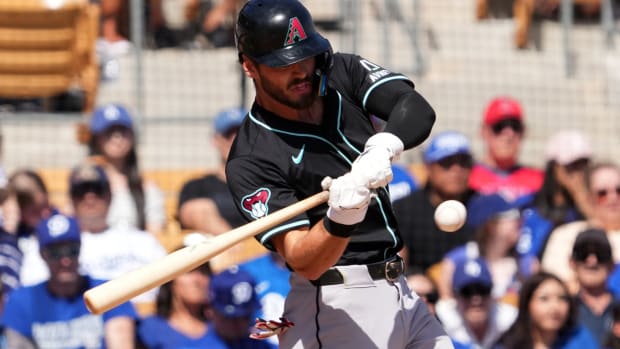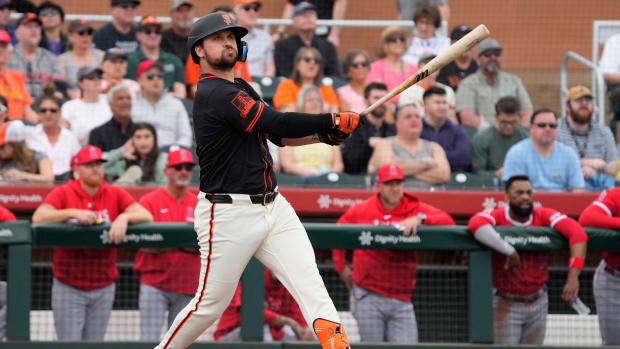Chances these young star players get a contract extension
John Hart's legacy grows greater with each passing day. As the general manager of the Indians in the 1990s, Hart pioneered the practice of signing young players to long-term contracts that bought out a player's arbitration and, in a few cases, some free-agent years. The player got substantial security, eliminating the downside risk. The team locked in upside and cost certainty while leveraging the cash in its coffers.
Twenty years on, the practice -- as well as changes in baseball's rule set and economics -- has had an enormous impact on team-building. Over the past week, the Giants, Diamondbacks and Rangers have all signed young stars to long-term contracts, keeping Buster Posey, Paul Goldschmidt and Elvis Andrus, respectively, off the free-agent market. Orioles catcher Matt Wieterscould be next in line, as Baltimore has reportedly reached out to his agent to get a deal done.
In a game flush with dollars, in which expenditures on the draft and on international talent are now set by rule, in which few true stars even reach the open market, every team has a mandate to sign the young players it develops. Twenty-one players produced at least 15 Wins Above Replacement from 2010 through 2012. Of those, just five have ever been major-league free agents. Not every team follows through -- Zack Greinke and Josh Hamilton were on the market last winter, Robinson Cano might be out there after this season -- but increasingly, your viability as a contender is contingent on finding talent early and locking it up for a long time.
So who's next? With the bar having being set awfully low by the Rays -- who locked up Evan Longoria and Matt Moore while both were still prone to getting lost between the clubhouse and the field -- many players are candidates for long-term deals. Let's start with the biggest names:
Bryce Harper, Nationals, and Mike Trout, Angels
The easiest time to make a decision on a player is when that player has demonstrated he's one of the best in baseball. Harper had one of the best seasons ever by a teenager last season, while Mike Trout was the best player in baseball at age 20. The problem is that performance like that upsets the balance between the two sides. It's hard to find a middle ground between a player who wants to be paid for established performance and a team that is looking to lock in some upside.
Neither Harper nor Trout is a strong candidate for a long-term deal right now. Of the two, Harper has a lot less leverage -- the Nats have him signed to an MLB deal that pays him $750,000 this year and a total of $1.9 million in 2014 and 2015. Harper isn't arbitration-eligible until after 2015, and he can't hit the free-agent market until after 2018. He's three calendar years from seeing money that approaches his real value. The Nationals can, if they choose, go year-to-year with Harper in arbitration and still probably make out pretty well in the deal. On the other hand, Harper is in line to be a free agent at 25 and could sign the most lucrative contract in baseball history at that time. It's hard to conceive of a middle ground here, at least until we see where Harper's prodigious talent takes him.
Trout represents the same problem, with tremendous performance paired with very little service time. The Giants' agreement with Buster Posey serves to illustrate the problem the Nationals and Angels face. By signing their star off a peak performance, the Giants got very little short-term value. Posey's arb-year salaries of $10.5 million, $16.5 million and $20 million are no discount from what he would be projected to make in arbitration. The Nats and Halos would be trying to do better at the table.
Trout is closer to free agency than is Harper and is not signed to a deal that buys out a year of arbitration, so the Angels are a bit more motivated to reach an agreement. Signing the reality-based 2012 AL MVP isn't easy; a deal may become more likely after Trout's 2013 season, which should be strong without necessarily reaching the same heights of his '12, is in the books.
Chance of long-term deal in next 12 months:Harper: 5%; Trout: 50%
The Braves missed a window to sign Heyward last spring, when he was coming off a disappointing 2011 season and off to a shaky start in '12. A deal in May of last year -- when Heyward hit .200/.315/.389 -- might have saved Atlanta millions. In general, teams are far too conservative about signing players at a low point in their value, failing to take advantage of opportunities where the player might be more worried about security.
In any case, the Braves have a 23-year-old star with tremendous raw skills and a mature approach for his age. Heyward, like Harper, can be a free agent so young (26) that he might choose that path, but if Wieters and the Orioles agree to stay together, then Heyward and the Braves are next to the altar.
Chance of deal:60%
Giancarlo Stanton, Marlins
Were the Marlins a normal franchise, they would have to sign Stanton. They have a new park and a tiny payroll with plenty of room to lock up their slugging rightfielder. The Marlins, of course, are not a normal franchise. Soft factors can be overstated, but it would seem a hard sell to convince Stanton to make a long-term commitment to a franchise that has never kept a long-term commitment to anything other than the public's coffers.
Stanton is four years from free agency but can begin going to arbitration this offseason. Perhaps a large arb award and the prospect of more to come will scare Miami into trading him to a team more willing to play money to baseball players in pursuit of a championship.
Chance of deal:15% in Miami, 75% after a trade
Rizzo was more ready last year than I expected him to be, hitting .285/.342/.463 with reasonable plate discipline. He looks like a No. 3 hitter for the Cubs' next NL Central champion. Chicago has some dead money on the payroll now, but a lot of room between what it can spend and what it has on the books for the next few years. Rizzo can't go to arbitration for two more years or become a free agent until after 2018, so the Cubs have some leverage.
Remember, teams have shown a willingness to pull the trigger on these contracts earlier and earlier. The current braintrust in Chicago, while in Boston, signed Jon Lester after his first full season and Dustin Pedroia after his second and, after reuniting in the Windy City, recently worked out a long-term contract with Starlin Castro.
Chance of deal: 75%
Pitchers are a different kettle of fish. On the one hand, the risk profile of hurlers is substantially different from hitters. On the other, the healthiest and best of the bunch blow up budgets when they reach the open market. There are two left-handers that 28 teams are hoping and praying fail to reach an agreement with their current teams: the Dodgers' Clayton Kershaw and the Rays' David Price.
The Dodgers and their ace lefty have never gone deep into talks on a long-term deal, owing largely to the franchise's ownership instability in the early years of Kershaw's career. Kershaw can hit the market after 2014; right now, he's making $11 million in the second year of a two-year contract. Once a player is under two years to the market, the leverage shifts to him. He can compare himself to free agents in his final year of arbitration, raising his potential salary in his walk year. Then he just needs one additional year of performance to hit the market, where the competition for the few superstar free agents can be fierce.
Kershaw has significantly less incentive to sign a long-term deal with Los Angeles than he would have two years ago. On the other hand, Justin Verlander was in a similar situation in Detroit, two years from free agency, and he worked out a deal with the Tigers. That contract, in effect a five-year, $140-million extension beginning in 2015, is the low-end for what a healthy Kershaw can get on the open market. The Dodgers have shown every willingness to overpay for talent they own and talent they do not, and it's hard to see them not tacking on millions until Kershaw cries "Uncle!". How about $200 million for seven years? Or $240 million for eight years, making him the first $30 million a year player? It's all possible.
Chance of deal: 65%
David Price, Rays
The Rays are, shall we say, unlikely to show such disregard for their budget. Their highest-ever payroll was in 2010, when they paid out $72.8 million. You can project revenue growth, team success, attendance bumps and maybe even a change to revenue-sharing rules, but you're not going to get the Rays' payroll to a place where it can pay $25 million to one player. Price is still three seasons from free agency, which tamps down the need to sign him, but Tampa Bay will be running the risk that Price, with more Cy Young-caliber work, can get a $25 million salary just through arbitration.
Unless the Rays can convince Price to play for substantially less than he might make over the next five years -- something like a five-year, $95-million offer, itself a stretch for the team -- they're going to have to deal him away by the start of next season. It's rare, under the past few Collective Bargaining Agreements, that a team is forced to deal away young talent because it genuinely can't afford it. Price, a great pitcher for a legitimately low-revenue team that doesn't seem to be able to change its situation no matter how well it plays, may be the exception to that rule.
Chance of deal: 5%




































